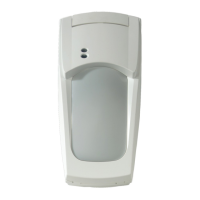P/N 145797999-2 • REV B • ISS 19MAR12 9 / 64
b. The red and yellow LEDs are blinking
simultaneously then the field of view is
obstructed and is insufficient to verify an
alarm.
There are two options:
• If the blinking started near the end of the
detection area, you need to align the beam
to the left (Figure 20, item 2).
• If the blinking started near the start of the
detection area, you need to align the beam
to the right (Figure 20, item 3).
Loosen the base fixation screws (see Figure 4)
and use the three adjustment screws in the
base to realign the beam to the centre, as
shown in Figure 20. When the beam is correctly
realigned, retighten the base fixation screws.
4. If the LEDs do not blink, the curtain is outside of
the detection range (Figure 20, item 4). Walk
across the beam at a shorter distance to try to
detect it.
5. Redo walk test to confirm that the detector is
correctly aligned.
6. Put J2 to Off.
Notes
• If the CLM is on, the alarm output is activated.
• It is recommended to place the cover on the
detector during the CLM walk test.
Identifying detector status by the LEDs
Table 2: LED indication
Detector
status
Yellow
LED
Red
LED
Description
Power On
Blinks alternatively for
50 s
Alarm
On during alarm period
— nominally for 3 s
Trouble
Continuously on
High/Low
voltage
On until correct voltage is
restored
= On steady = Blinking (1 Hz)
General information
Latching
When using multiple detectors in a single loop, wire
for day/night (D/N) and walk test (WT) inputs, as
shown in Figure 6.
Remotely enabling/disabling the walk test LED
See Figure 6.
Disconnect the CV to terminal 10 (D/N) and
connect it to terminal 11. The detector’s LED will
blink as the alarm relay opens and closes. The walk
test can now be carried out.
Note: Only enabling the walk test will not clear the
alarm memory. After disarming the system
following an alarm, switch the walk test to On.
When you switch walk test to Off, the indication of
memorised alarms will reappear. Only when CV is
re-applied to terminal 10 (i.e., the system is
rearmed) will the memory be cleared and the LEDs
turned off.
To enable the walk test LED without a remote CV
input, set DIP switch 4 to the On position. After
walk test, set DIP switch 4 to the Off position.
We recommend that the detector is regularly walk
tested and the communication with the control
panel checked.
Setting the alarm memory
See Figure 6.
Note: First set the appropriate active polarity of the
control voltage (CV) using the PIR DIP switch 1.
Connect the CV to terminal 10 when the system is
armed. When the system is disarmed, disconnect
the CV. If an alarm occurs during the armed period,
a flashing red LED will indicate which the
detector(s) caused the alarm. Re-applying the CV
(re-arming the system) will reset the LED indication
and memory.
Selecting the coverage pattern
See Figures 21 and 22.
The coverage pattern can be changed to fit specific
requirements by using the mirror stickers
(enclosed), as shown. We recommend that you
blind unused curtains that are looking at objects
located very close to the detector.

